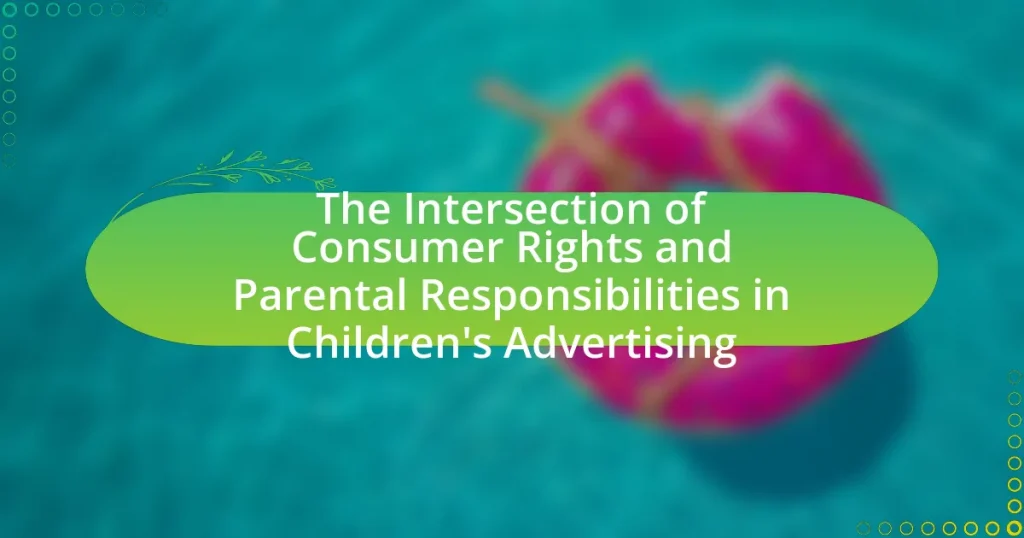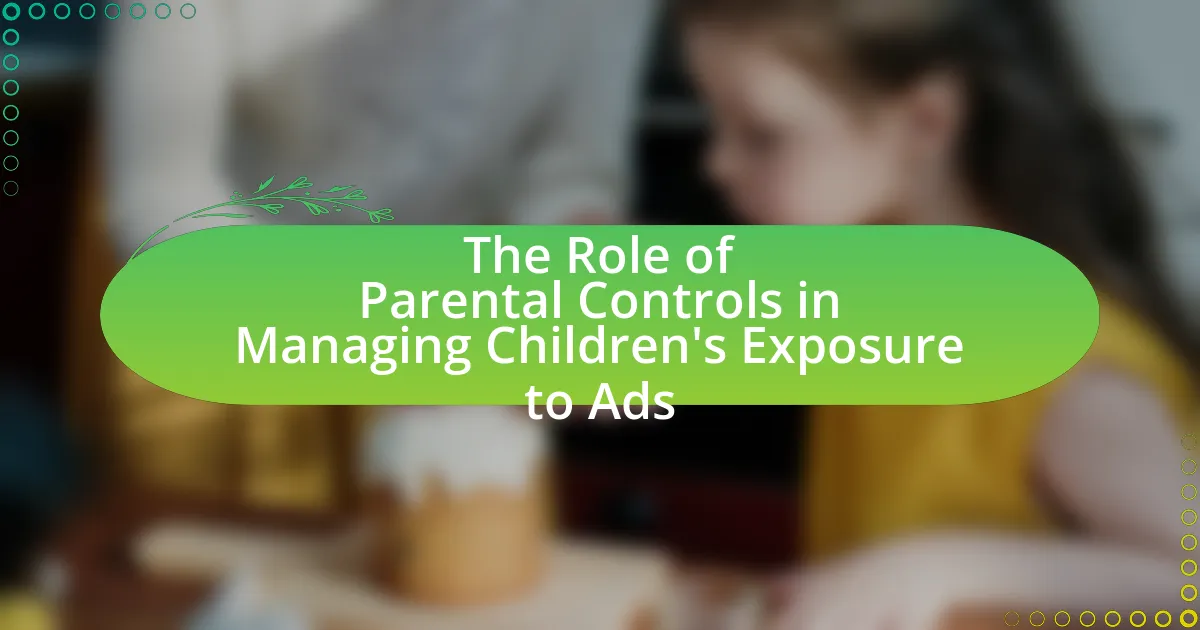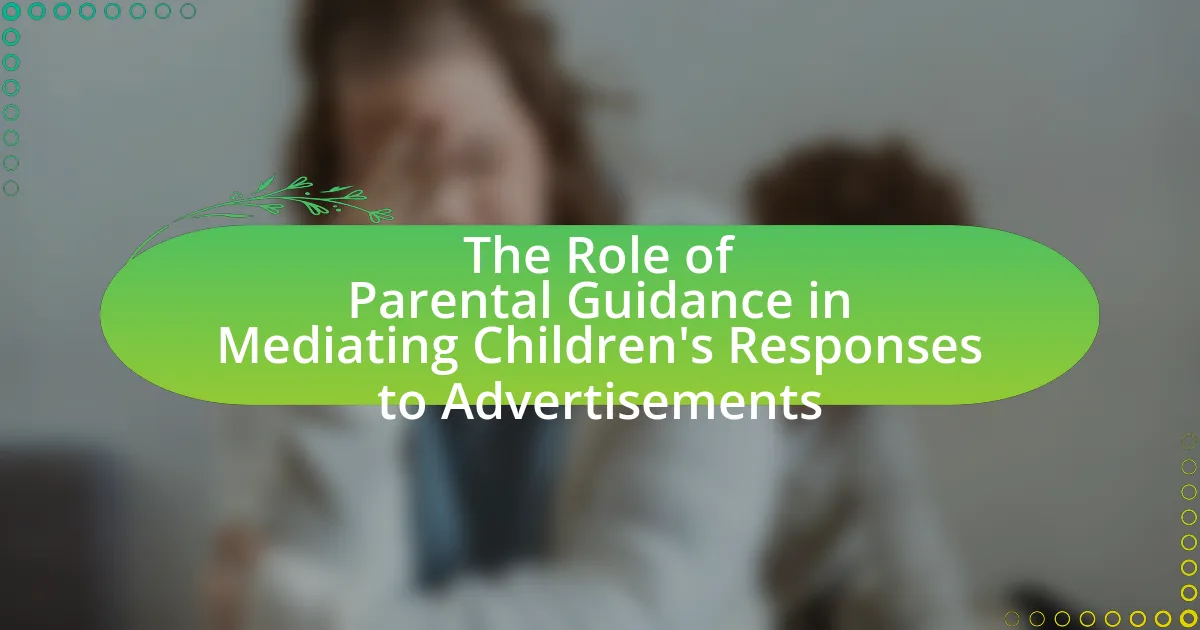The article examines the intersection of consumer rights and parental responsibilities in children’s advertising, highlighting the importance of protecting young audiences from misleading marketing practices. It outlines key consumer rights, such as the right to truthful information and privacy, enforced by regulations like the Children’s Online Privacy Protection Act (COPPA) and the Federal Trade Commission Act. The article also discusses the role of parents in monitoring advertising content, educating their children about advertising tactics, and advocating for responsible marketing practices. Additionally, it addresses the challenges parents face in navigating advertising influences and emphasizes the need for collaboration among stakeholders to enhance advertising standards for children.
What are Consumer Rights in the Context of Children’s Advertising?
Consumer rights in the context of children’s advertising include the right to truthful information, protection from misleading claims, and the right to privacy. These rights are established to safeguard children from exploitation and manipulation in marketing practices. For instance, regulations such as the Children’s Online Privacy Protection Act (COPPA) in the United States enforce strict guidelines on how children’s data can be collected and used, ensuring that advertisers cannot exploit children’s naivety. Additionally, the Federal Trade Commission (FTC) emphasizes that advertisements directed at children must be clearly distinguishable from other content, reinforcing the need for transparency and honesty in marketing aimed at young audiences.
How do consumer rights protect children from misleading advertisements?
Consumer rights protect children from misleading advertisements by establishing regulations that prohibit deceptive marketing practices aimed at minors. These regulations, enforced by agencies such as the Federal Trade Commission (FTC) in the United States, require that advertisements directed at children must be truthful and not exploit their inexperience or credulity. For instance, the Children’s Online Privacy Protection Act (COPPA) mandates that companies obtain parental consent before collecting personal information from children, thereby limiting the potential for misleading advertisements that could manipulate young audiences. Additionally, consumer protection laws often include provisions that allow parents to file complaints against misleading advertisements, ensuring accountability and promoting ethical advertising practices.
What specific laws govern children’s advertising practices?
The specific laws that govern children’s advertising practices include the Children’s Online Privacy Protection Act (COPPA), the Federal Trade Commission Act (FTC Act), and various state laws that regulate advertising to minors. COPPA mandates that websites and online services directed at children under 13 must obtain parental consent before collecting personal information, thereby protecting children’s privacy in digital advertising. The FTC Act prohibits unfair or deceptive acts or practices in commerce, which includes misleading advertising targeted at children. Additionally, many states have enacted laws that impose stricter regulations on advertising to minors, focusing on issues such as the content and timing of advertisements. These laws collectively aim to safeguard children from exploitative marketing practices and ensure that advertising is appropriate for their age group.
How do these laws vary across different countries?
Laws regarding consumer rights and parental responsibilities in children’s advertising vary significantly across countries. For instance, in the United States, the Federal Trade Commission regulates advertising to children under the Children’s Online Privacy Protection Act, which mandates parental consent for data collection. In contrast, the European Union enforces stricter regulations under the Audiovisual Media Services Directive, which limits advertising to children and requires clear labeling of commercial content. Additionally, countries like Sweden and Norway have outright bans on advertising to children under 12, reflecting a more protective stance. These differences illustrate how cultural values and legal frameworks shape the approach to children’s advertising globally.
Why is it important to uphold consumer rights in children’s advertising?
Upholding consumer rights in children’s advertising is crucial to protect young audiences from misleading or harmful marketing practices. Children are particularly vulnerable to advertising tactics due to their limited ability to critically evaluate messages, making it essential to ensure that advertisements are truthful and not exploitative. Research indicates that children under the age of 8 cannot distinguish between advertising and entertainment, which underscores the need for strict regulations to prevent deceptive practices. By enforcing consumer rights, regulatory bodies can help create a safer advertising environment that promotes ethical standards and supports informed decision-making by both children and their parents.
What are the potential consequences of neglecting consumer rights?
Neglecting consumer rights can lead to significant negative consequences, including financial loss for consumers, erosion of trust in businesses, and potential legal repercussions for companies. When consumer rights are overlooked, individuals may face unfair pricing, substandard products, or inadequate services, resulting in economic harm. For instance, a study by the Consumer Federation of America found that consumers lose billions annually due to deceptive practices. Additionally, businesses that fail to uphold consumer rights risk damaging their reputation, which can lead to decreased customer loyalty and sales. Legal consequences may also arise, as regulatory bodies can impose fines or sanctions on companies that violate consumer protection laws, further emphasizing the importance of respecting consumer rights.
How do consumer rights influence the marketing strategies of companies?
Consumer rights significantly influence the marketing strategies of companies by necessitating transparency, ethical practices, and compliance with regulations. Companies must adapt their marketing approaches to ensure they respect consumer rights, such as the right to information, the right to choose, and the right to safety. For instance, regulations like the General Data Protection Regulation (GDPR) in Europe require companies to be transparent about data collection and usage, prompting them to develop marketing strategies that prioritize consumer consent and data protection. Additionally, companies that prioritize ethical marketing practices often enhance their brand reputation and customer loyalty, as consumers increasingly favor brands that align with their values regarding rights and responsibilities. This alignment is particularly crucial in children’s advertising, where companies must navigate stricter regulations to protect young consumers, thereby shaping their marketing strategies to be more responsible and compliant.
What are Parental Responsibilities in Children’s Advertising?
Parental responsibilities in children’s advertising include ensuring that advertisements are appropriate, truthful, and do not exploit children’s inexperience or credulity. Parents must actively monitor the content their children are exposed to, advocating for advertising that promotes healthy behaviors and values. Research indicates that children are particularly vulnerable to persuasive advertising techniques, which can lead to unhealthy consumption patterns. For instance, the American Psychological Association highlights that children under eight often cannot distinguish between programming and advertising, underscoring the need for parental vigilance in guiding their media consumption.
How can parents effectively monitor advertising targeted at their children?
Parents can effectively monitor advertising targeted at their children by utilizing digital tools, setting clear guidelines, and engaging in open discussions about media consumption. Digital tools such as parental control software and ad-blockers can limit exposure to inappropriate advertisements. Research indicates that children aged 8 to 12 are particularly susceptible to advertising, making it crucial for parents to actively supervise their media environment. Additionally, establishing rules regarding screen time and the types of content children can access helps create a structured viewing experience. Engaging in conversations about the intent behind advertisements fosters critical thinking, enabling children to understand marketing strategies. Studies show that children who discuss advertising with their parents are better equipped to recognize persuasive techniques, thus enhancing their media literacy.
What tools and resources are available for parents to assess advertisements?
Parents can utilize various tools and resources to assess advertisements, including media literacy programs, online databases, and regulatory guidelines. Media literacy programs, such as those offered by organizations like Common Sense Media, provide parents with strategies to critically evaluate advertisements and understand their impact on children. Online databases, such as the Federal Trade Commission’s (FTC) resources, offer insights into advertising practices and consumer rights, helping parents identify misleading claims. Additionally, guidelines from the American Psychological Association outline best practices for evaluating children’s advertising, emphasizing the importance of understanding the persuasive techniques used in marketing. These resources collectively empower parents to make informed decisions regarding the advertisements their children encounter.
How can parents educate their children about advertising tactics?
Parents can educate their children about advertising tactics by discussing the purpose and techniques of advertisements. Engaging children in conversations about how ads are designed to persuade them can help them recognize strategies such as emotional appeals, celebrity endorsements, and targeted messaging. Research indicates that children as young as 8 years old can understand the persuasive intent of advertisements when guided appropriately. By analyzing specific ads together, parents can illustrate how visuals, slogans, and music are used to influence consumer behavior. This hands-on approach not only enhances critical thinking skills but also empowers children to make informed decisions as consumers.
What role do parents play in advocating for consumer rights?
Parents play a crucial role in advocating for consumer rights by educating their children about responsible consumption and protecting them from misleading advertising. They actively engage in discussions about the value of products, the importance of critical thinking regarding advertisements, and the implications of consumer choices. Research indicates that parents who model informed consumer behavior significantly influence their children’s understanding of consumer rights, as evidenced by a study published in the Journal of Consumer Research, which found that parental guidance enhances children’s ability to discern advertising tactics. This involvement not only empowers children but also fosters a culture of consumer advocacy within families, reinforcing the importance of ethical marketing practices.
How can parents collaborate with organizations to promote responsible advertising?
Parents can collaborate with organizations to promote responsible advertising by actively participating in advocacy groups and engaging in dialogue with companies about ethical marketing practices. By joining forces with organizations focused on consumer rights, parents can influence policies that protect children from misleading advertisements. Research indicates that parental involvement in advocacy can lead to more stringent advertising regulations, as seen in the 2011 Federal Trade Commission report, which highlighted the impact of public input on advertising standards. This collaboration can also include supporting educational initiatives that inform children about advertising tactics, thereby fostering critical thinking skills.
What are the challenges parents face in fulfilling their responsibilities?
Parents face significant challenges in fulfilling their responsibilities, particularly in the context of children’s advertising. One major challenge is the pervasive influence of marketing strategies that target children, which can undermine parental authority and decision-making. Research indicates that children are exposed to an average of 30,000 advertisements per year, leading to increased pressure on parents to manage their children’s consumption habits effectively. Additionally, parents often struggle with balancing work and family life, which can limit their ability to monitor and guide their children’s media consumption. The American Psychological Association highlights that this imbalance can lead to difficulties in instilling healthy consumer habits in children. Furthermore, the rapid evolution of digital media complicates parental oversight, as many parents may lack the technical knowledge to navigate online advertising and its implications for their children.
How do Consumer Rights and Parental Responsibilities Intersect in Children’s Advertising?
Consumer rights and parental responsibilities intersect in children’s advertising by ensuring that advertisements are truthful and not misleading while also requiring parents to guide their children’s consumption choices. Consumer rights protect children from deceptive marketing practices, as regulations like the Children’s Online Privacy Protection Act (COPPA) mandate that companies obtain parental consent before collecting personal information from children under 13. Simultaneously, parental responsibilities involve monitoring and regulating children’s exposure to advertisements, as parents are expected to educate their children about advertising tactics and make informed decisions on their behalf. This dual framework aims to create a safer advertising environment for children while empowering parents to take an active role in their children’s media consumption.
What are the implications of the intersection between consumer rights and parental responsibilities?
The intersection between consumer rights and parental responsibilities implies that parents must navigate the complexities of protecting their children from misleading advertising while also ensuring their children’s rights as consumers are respected. This dual obligation requires parents to critically assess marketing practices aimed at children, as studies indicate that children are particularly vulnerable to persuasive advertising techniques, which can lead to unhealthy consumption patterns. For instance, research published in the Journal of Consumer Research highlights that children under the age of 8 often lack the cognitive ability to understand the persuasive intent behind advertisements, emphasizing the need for parental oversight. Consequently, parents are tasked with the responsibility of educating their children about consumer rights and making informed choices that safeguard their well-being in a marketplace that often prioritizes profit over ethical considerations.
How can understanding this intersection benefit children?
Understanding the intersection of consumer rights and parental responsibilities in children’s advertising can significantly benefit children by ensuring they are protected from misleading marketing practices. When parents are informed about their rights and responsibilities, they can advocate for their children, promoting a safer advertising environment that prioritizes children’s well-being. Research indicates that children are particularly vulnerable to advertising tactics, which can lead to unhealthy consumption habits and unrealistic expectations. By understanding this intersection, parents can make informed decisions about the media their children consume, fostering critical thinking skills and promoting healthier lifestyle choices. This proactive approach not only empowers parents but also cultivates a more responsible advertising landscape that respects children’s developmental needs.
What are the potential conflicts between consumer rights and parental responsibilities?
Potential conflicts between consumer rights and parental responsibilities arise when parents’ duty to protect their children from harmful marketing practices clashes with children’s rights to access information and make choices as consumers. For instance, parents may restrict their children’s exposure to certain advertisements or products they deem inappropriate, while consumer rights advocate for children’s autonomy in making purchasing decisions. This tension is evident in regulations like the Children’s Online Privacy Protection Act (COPPA), which aims to protect children’s privacy online but can limit parents’ ability to monitor their children’s online activities. Additionally, parents may feel pressured to purchase products marketed to children, which can conflict with their responsibility to ensure their children make healthy and informed choices.
How can stakeholders work together to enhance children’s advertising standards?
Stakeholders can enhance children’s advertising standards by collaborating to establish clear guidelines and regulations that prioritize child welfare. This collaboration can involve government agencies, advertising companies, parents, educators, and child advocacy groups working together to create a framework that limits misleading advertisements and promotes educational content. For instance, the Federal Trade Commission (FTC) has previously emphasized the importance of protecting children from deceptive marketing practices, which can serve as a foundation for these stakeholders to develop more stringent standards. By sharing research, resources, and best practices, stakeholders can ensure that advertising is not only compliant with legal standards but also ethically responsible, ultimately fostering a safer advertising environment for children.
What best practices can be implemented to ensure ethical advertising?
To ensure ethical advertising, companies should prioritize transparency, truthfulness, and respect for consumer rights. Transparency involves clearly disclosing the nature of the advertisement, including sponsorship and potential conflicts of interest. Truthfulness requires that all claims made in advertisements are accurate and substantiated, avoiding misleading information. Respect for consumer rights includes protecting vulnerable populations, such as children, by adhering to guidelines that prevent exploitation and ensure that advertisements are age-appropriate. For instance, the American Psychological Association emphasizes the importance of ethical standards in advertising directed at children, highlighting the need for responsible messaging that does not manipulate or deceive young audiences.
How can parents and companies collaborate to protect children’s interests?
Parents and companies can collaborate to protect children’s interests by establishing clear communication channels and creating guidelines that prioritize child safety and well-being in advertising. Parents can provide insights into their children’s needs and preferences, while companies can implement responsible marketing practices that avoid exploiting children’s vulnerabilities. For instance, the Children’s Advertising Review Unit (CARU) sets standards for responsible advertising to children, which companies can adopt to ensure compliance with ethical guidelines. This collaboration can lead to the development of educational programs that inform both parents and children about consumer rights, fostering a safer advertising environment.
What practical steps can parents take to navigate children’s advertising effectively?
Parents can navigate children’s advertising effectively by actively engaging in discussions about advertisements and teaching critical thinking skills. By explaining the intent behind advertisements, parents can help children understand persuasive techniques and differentiate between needs and wants. Research indicates that children aged 8 to 12 are particularly susceptible to advertising messages, making parental guidance crucial in this developmental stage. Additionally, parents can set limits on screen time and monitor the types of media their children consume, which can reduce exposure to potentially misleading advertisements. Implementing these strategies fosters media literacy and empowers children to make informed choices regarding advertising.
How can parents engage in discussions with their children about advertising messages?
Parents can engage in discussions with their children about advertising messages by actively analyzing advertisements together and encouraging critical thinking. This involves asking children questions about the ads they see, such as what the ad is trying to sell, who the target audience is, and whether the message is truthful or misleading. Research indicates that children as young as 8 years old can understand persuasive intent in advertising, making it crucial for parents to guide them in recognizing marketing tactics. By fostering an environment where children feel comfortable expressing their thoughts, parents can help them develop media literacy skills that are essential for navigating the complex landscape of advertising.
What resources are available for parents to stay informed about advertising regulations?
Parents can stay informed about advertising regulations through several key resources. The Federal Trade Commission (FTC) provides comprehensive guidelines and updates on advertising practices, particularly those affecting children, which can be accessed on their official website. Additionally, the Children’s Advertising Review Unit (CARU) offers resources and reports on advertising standards specifically aimed at children, helping parents understand what is considered appropriate. Furthermore, advocacy organizations such as Common Sense Media provide insights and analyses on advertising impacts on children, along with educational materials for parents. These resources collectively ensure that parents are equipped with the necessary information to navigate advertising regulations effectively.






